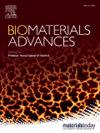Abdominal PP meshes coated with functional core-sheath biodegradable nanofibers with anticoagulant and antibacterial properties
IF 5.5
2区 医学
Q2 MATERIALS SCIENCE, BIOMATERIALS
Materials Science & Engineering C-Materials for Biological Applications
Pub Date : 2025-01-03
DOI:10.1016/j.bioadv.2024.214163
引用次数: 0
Abstract
Abdominal hernia repair is a common surgical procedure, involving in most cases the use of textile meshes providing a mechanical barrier to consolidate the damaged surrounding tissues and prevent the resurgence of the hernia. However, in more than half cases postoperative complications such as adhesions and infections occur at the surface of the mesh, leading to chronic pain for the patient and requiring the removal of the implant. One of the most promising strategies to reduce the risk of postoperative adhesions and infections is to add a physical barrier between the mesh and the abdominal walls. In this study, we propose a strategy to develop functional hernia meshes possessing anticoagulant and antibacterial activities depending on the side of the implant. Two bioactive polymers were synthetized: a polysulfonate (poly(2-acrylamido-2-methylpropane sulfonic acid), PAMPS) one for anticoagulant activity and a polymer bearing ternary amines (poly((2-tert-butylamino) ethyl methacrylate), PTBAEMA) for antibacterial activity. These polymers were used to produce core-sheath nanofibers thanks to coaxial electrospinning with poly(ɛ-caprolactone) (PCL) as core and the bioactive polymer as sheath. The electrospinning parameters were optimized in order to obtain defect-free nanofibrous coatings onto the mesh with improved stability in water. The core-sheath structure was investigated as well as the presence of the functional groups at the surface. The in vitro cytocompatibility, anticoagulant activity and antibacterial activity were evaluated and highlighted the high potential of these coatings for the simultaneous prevention of postoperative adhesions and infections.

具有抗凝血和抗菌性能的功能性芯鞘可生物降解纳米纤维包覆的腹部PP网。
腹疝修补是一种常见的外科手术,在大多数情况下,使用纺织网提供机械屏障来巩固受损的周围组织,防止疝复发。然而,在超过一半的病例中,术后并发症如粘连和感染发生在补片表面,导致患者慢性疼痛并需要移除植入物。减少术后粘连和感染风险的最有希望的策略之一是在补片和腹壁之间添加物理屏障。在这项研究中,我们提出了一种开发具有抗凝血和抗菌活性的功能性疝补片的策略,这取决于植入物的侧面。合成了两种具有生物活性的聚合物:具有抗凝血活性的聚磺酸(聚(2-丙烯酰胺-2-甲基丙烷磺酸),PAMPS)和具有抗菌活性的三元胺(聚(2-叔丁基氨基)甲基丙烯酸乙酯,PTBAEMA)聚合物。以聚己内酯(PCL)为芯,生物活性聚合物为鞘,采用同轴静电纺丝技术制备了芯-鞘纳米纤维。通过对静电纺丝工艺参数的优化,得到了无缺陷的纳米纤维涂层,并提高了涂层在水中的稳定性。研究了核鞘结构以及表面官能团的存在。体外细胞相容性、抗凝血活性和抗菌活性进行了评估,并强调了这些涂层在同时预防术后粘连和感染方面的巨大潜力。
本文章由计算机程序翻译,如有差异,请以英文原文为准。
求助全文
约1分钟内获得全文
求助全文
来源期刊
CiteScore
17.80
自引率
0.00%
发文量
501
审稿时长
27 days
期刊介绍:
Biomaterials Advances, previously known as Materials Science and Engineering: C-Materials for Biological Applications (P-ISSN: 0928-4931, E-ISSN: 1873-0191). Includes topics at the interface of the biomedical sciences and materials engineering. These topics include:
• Bioinspired and biomimetic materials for medical applications
• Materials of biological origin for medical applications
• Materials for "active" medical applications
• Self-assembling and self-healing materials for medical applications
• "Smart" (i.e., stimulus-response) materials for medical applications
• Ceramic, metallic, polymeric, and composite materials for medical applications
• Materials for in vivo sensing
• Materials for in vivo imaging
• Materials for delivery of pharmacologic agents and vaccines
• Novel approaches for characterizing and modeling materials for medical applications
Manuscripts on biological topics without a materials science component, or manuscripts on materials science without biological applications, will not be considered for publication in Materials Science and Engineering C. New submissions are first assessed for language, scope and originality (plagiarism check) and can be desk rejected before review if they need English language improvements, are out of scope or present excessive duplication with published sources.
Biomaterials Advances sits within Elsevier''s biomaterials science portfolio alongside Biomaterials, Materials Today Bio and Biomaterials and Biosystems. As part of the broader Materials Today family, Biomaterials Advances offers authors rigorous peer review, rapid decisions, and high visibility. We look forward to receiving your submissions!

 求助内容:
求助内容: 应助结果提醒方式:
应助结果提醒方式:


